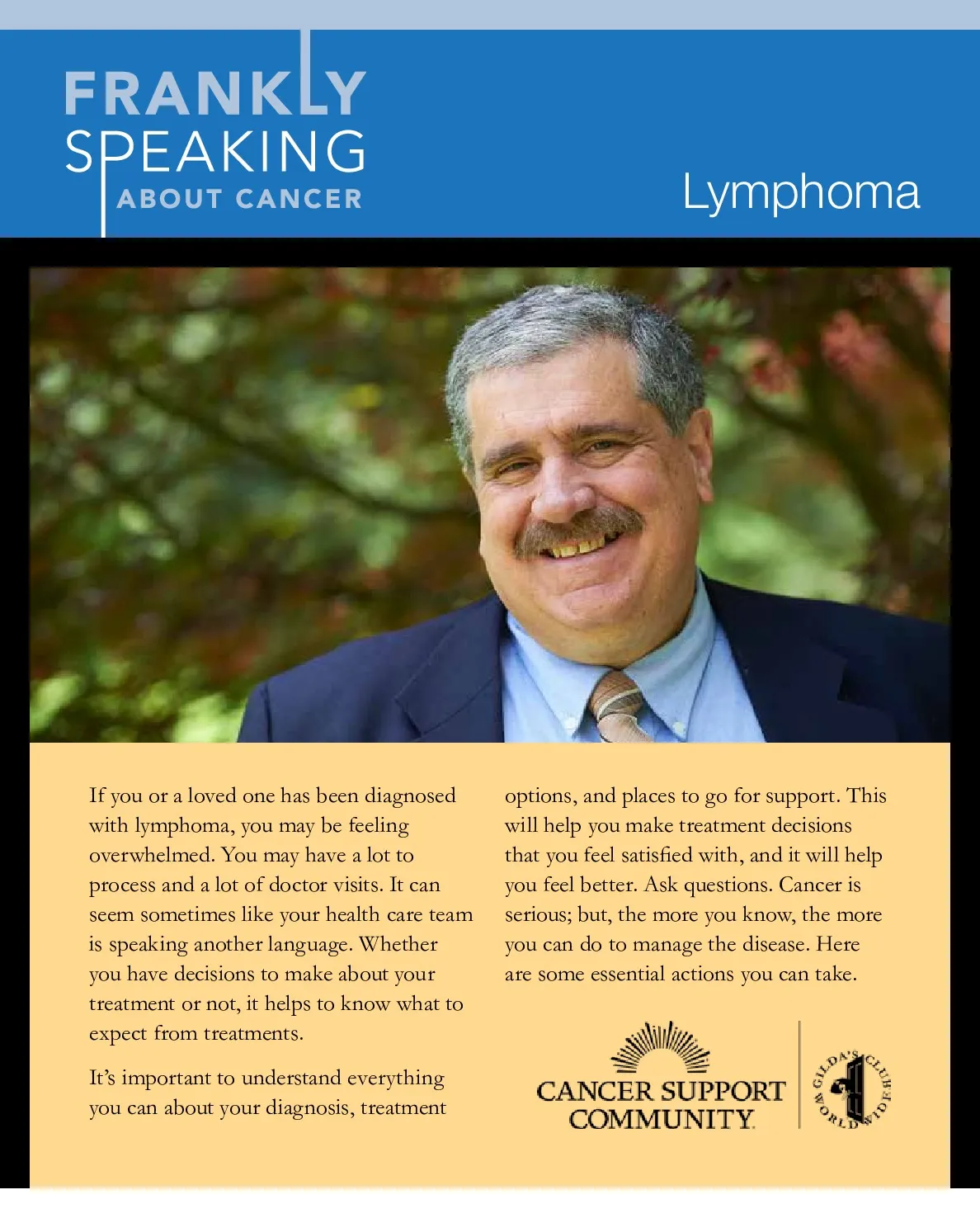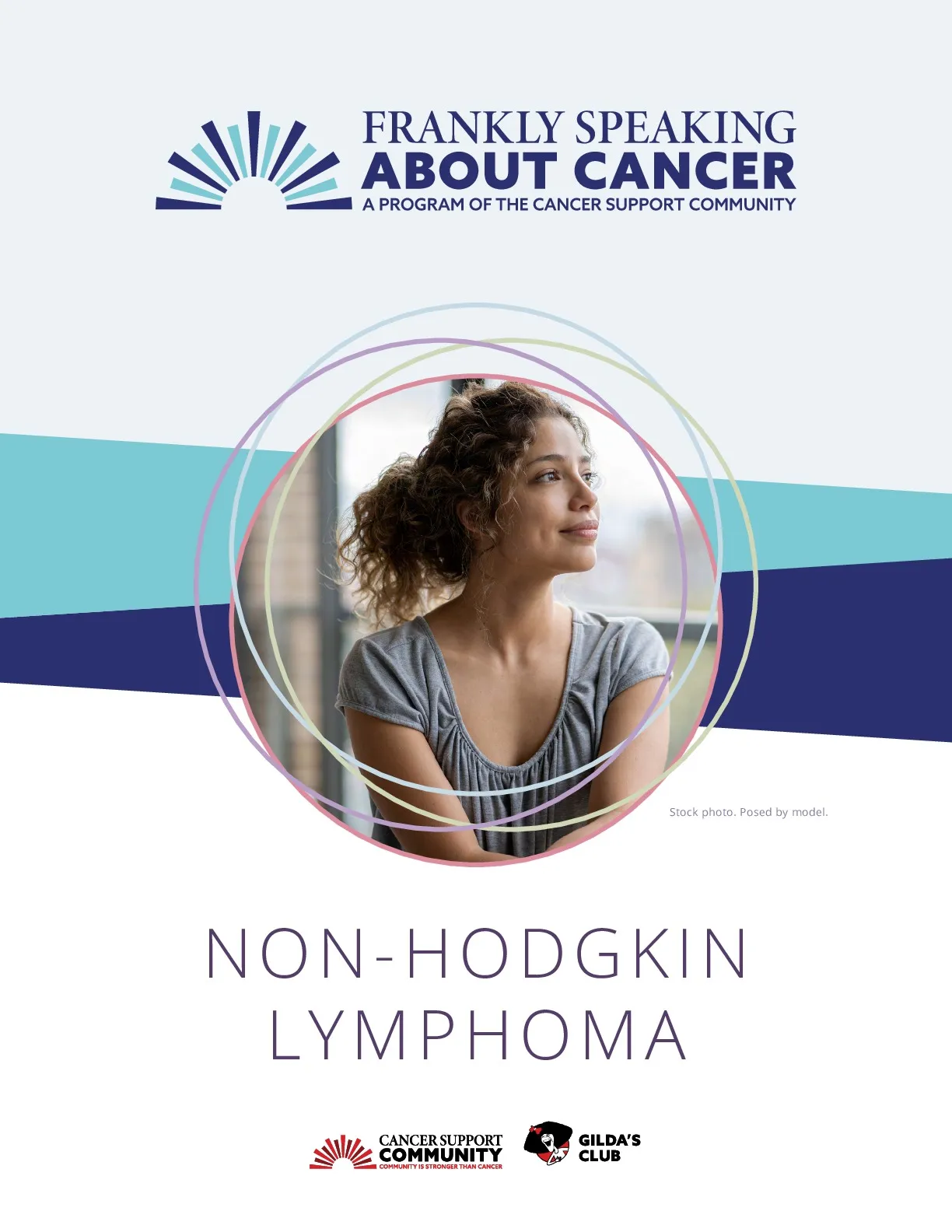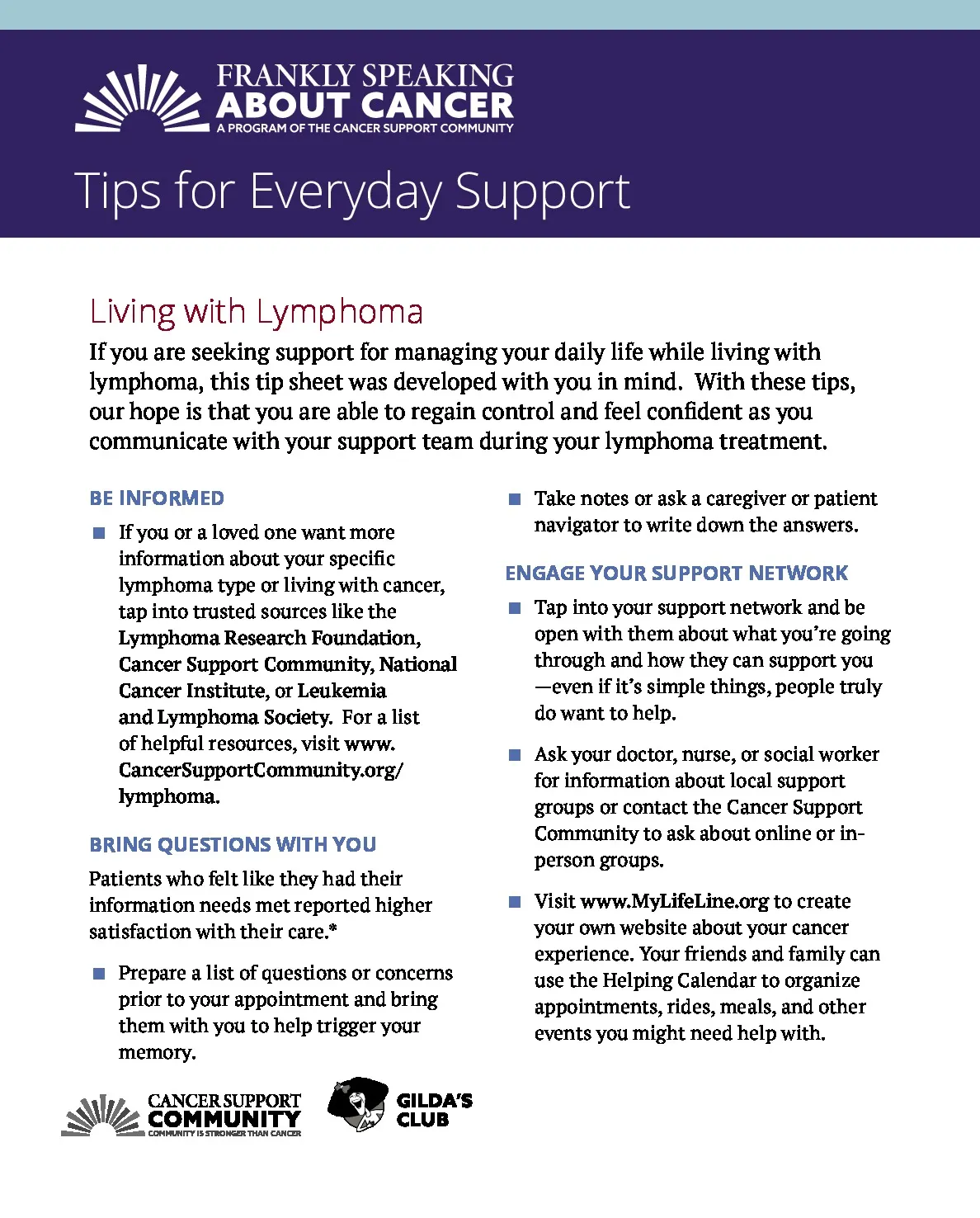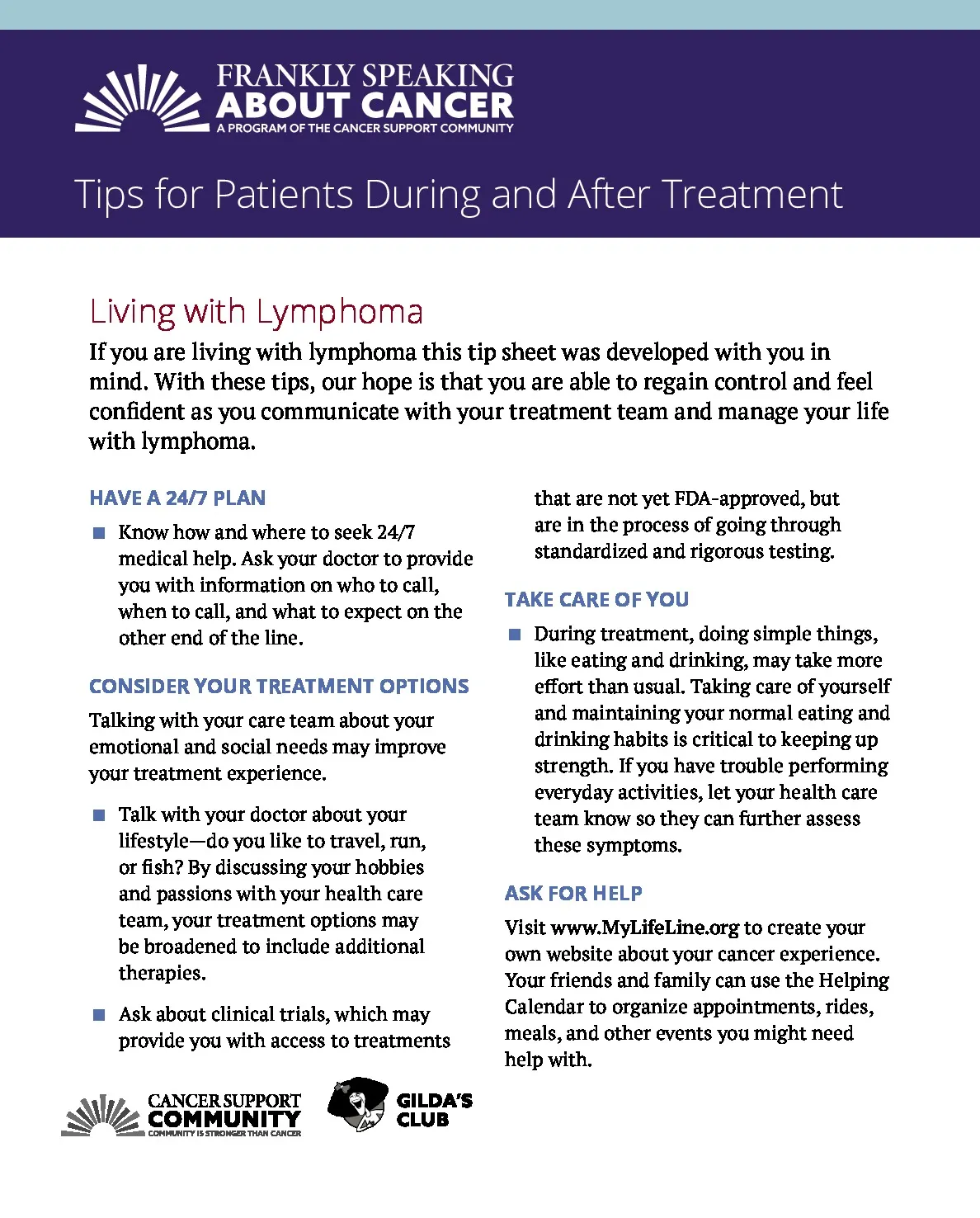Non-Hodgkin Lymphoma
Table of Contents
Non-Hodgkin lymphoma (NHL) is one of the most common cancers in the United States. It accounts for about 4 percent of all cancer cases. More than 95 percent of cases occur in adults, but certain types are common among children. NHL is the name of a group of blood cancers that develop in the white blood cells (leukocytes). NHL can be either indolent (slow growing) or aggressive (fast growing).
Types of Non-Hodgkin Lymphoma
There are about 60 different subtypes of Non-Hodgkin lymphoma. Most subtypes fall into two main groups named for the cell where the lymphoma starts: B-cell lymphomas or T-cell lymphomas. Most NHL starts in B-cells.
B-Cell Lymphomas
These make up most (about 85 percent) of the NHL cases in the United States. The majority of B-cell lymphomas are either diffuse large B-cell lymphoma (DLBCL) or follicular lymphoma (FL).
Diffuse large B-cell lymphoma (DLBCL) accounts for about one out of every three cases of NHL. This type of aggressive NHL occurs mostly in people who are older. In rare cases it occurs in children and younger adults. The average age at diagnosis is mid-60s to 70 years old.
DLBCL usually starts as a quickly growing mass in a lymph node in the chest or abdomen, or in a lymph node you can feel, such as the neck or armpit. It can grow in other areas such as the intestines, bone, or even the brain or spinal cord. Although this is a fast-growing lymphoma, DLBCL usually responds well to treatment. It can sometimes be cured entirely with chemotherapy.
Diffuse Large B Cell Lymphoma
Diffuse large B cell lymphoma (DLBCL) is the most common form of non-Hodgkin lymphoma.
Follicular lymphoma (FL) accounts for nearly 20 percent of lymphomas in the United States. The average age for people with this lymphoma is about 60. FL rarely occurs in very young people. This lymphoma usually appears in many lymph nodes throughout the body and in the bone marrow.
FL is often slow-growing. It can be treated but is difficult to cure. This type of lymphoma may not require any treatment at first. Many people with FL live for a decade or more with this disease. Depending on certain factors, treatment may be delayed until the disease grows or the person begins to have symptoms. When needed, treatment is often effective. It may lead to a period of remission (when all signs of your cancer are gone) after which the cancer returns. In 25-60 percent of people with FL, their disease eventually turns into a more aggressive large cell lymphoma. This usually does not happen until quite some time after diagnosis, often years later.
Other subtypes of B-cell lymphomas include:
- Mucosa-associated lymphatic tissue (MALT) lymphoma
- Small cell lymphocytic lymphoma/chronic lymphocytic leukemia (SLL/CLL)
- Mantle cell lymphoma (MCL)
- Mediastinal (thymic) large B-cell lymphoma
- Lymphoplasmacytic lymphoma and Waldenstrom macroglobulinemia
- Nodal marginal zone B-cell lymphoma
- Splenic marginal zone lymphoma
- Extranodal marginal zone B-cell lymphoma
- Intravascular large B-cell lymphoma
- Primary effusion lymphoma
- Burkitt lymphoma
- Primary central nervous system lymphoma
T-Cell Lymphomas
These make up less than 15 percent of NHL cases in the United States. T-cell lymphomas can be aggressive (fast growing) or indolent (slow growing). Common subtypes of T-cell lymphomas include:
- Peripheral T-cell lymphoma, not otherwise specified (PTCL-NOS)
- Cutaneous T-cell lymphoma (Sézary syndrome and mycosis fungoides)
- Anaplastic large cell lymphoma
- Angioimmunoblastic T-cell lymphoma
Risk Factors
Risk factors are things that can increase the chance of developing a disease. Certain cancer risk factors, such as smoking, can be changed.
Other cancer risk factors, like a person’s age or family history, cannot be changed. Having one or even many risk factors does not mean that a person will get the disease.
These are risk factors for non-Hodgkin lymphoma (NHL):
- Age
- Biological Sex
- Geography
- Race and Ethnicity
- Body Weight
- Radiation Exposure
- Chemical Exposure
- Immune Suppression
- Breast Implants
Although NHL can be diagnosed at any age, people are often diagnosed when they are 60 or older.
NHL occurs more often in men than women. But there are certain types of NHL that are more common in women. Reasons for this are not known.
NHL is more common in North America and northern Europe. It is least common in Asian countries. Worldwide, NHL is more common in developed countries.
In the U.S., whites are more likely to develop NHL than African Americans or Asian Americans/Pacific Islanders.
Keeping your body at a healthy weight and eating a good diet may reduce the risk of NHL. Some studies have suggested that being overweight or obese and eating a diet high in fats and meats may raise the risk of NHL.
Exposure to atomic bombs and nuclear reactor accidents can increase your risk of developing a number of cancers, including NHL, leukemia, and thyroid cancers. People treated with radiation therapy for certain cancers also have a slightly higher risk of developing NHL.
Exposure to chemicals such as benzene, certain herbicides (weed killers) and insecticides (insect killers) may be linked to an increased risk of NHL. Chemotherapy drugs used to treat other cancers may also increase the risk of developing NHL. It is not clear whether the link between chemotherapy drugs and NHL is related to the original cancer itself or is a side effect of treatment.
People who have a suppressed immune system are at increased risk for NHL. This includes those with the human immunodeficiency virus (HIV). It also includes anyone who takes immune suppression treatment for conditions like rheumatoid arthritis or lupus. People who have received solid organ transplants are also at increased risk of NHL, because they must take long-term immune suppression drugs to keep the transplanted organ healthy.
There have been rare cases of women with breast implants developing a type of NHL called anaplastic large cell lymphoma in scar tissue.
There are also some specific infections that increase your risk of developing NHL:
- Infections that Weaken the Immune System
- Infections that Affect Lymphocytes
- Infections that Activate the Immune System
HIV Infection – The risk of developing certain types of NHL, such as Burkitt lymphoma, is higher in people with human immunodeficiency virus (HIV), the virus that causes AIDS.
Viruses, including the human T-cell leukemia/lymphoma virus (HTLV-1) and the Epstein-Barr virus (EBV), affect the DNA of lymphocytes. Infection with HTLV-1 increases a person’s risk of developing certain T-cell lymphomas. It is most common in parts of Asia and the Caribbean. Infection with EBV is a risk factor for Burkitt lymphoma and rare forms of NHL.
Certain long-term infections may raise the risk of developing NHL by forcing the immune system to always be activated or “turned on.” As the body makes more lymphocytes to fight an infection, the chances of a genetic mutation that could lead to NHL increases. Infection with bacteria and viruses such as Helicobacter pylori, Campylobacter jejuni, and Hepatitis C are risk factors for NHL.
Signs & Symptoms
Many of the signs and symptoms of NHL are similar to those of Hodgkin lymphoma (HL).
Common signs and symptoms may include:
- Abdominal Swelling
- Coughing and Breathing Issues
- Fatigue and Loss of Appetite
- Fever
- Lumps
- Night Sweats
- Weight Loss
- Central Nervous System Changes
A tumor or large collection of fluid may cause the abdomen to become swollen and tender. Swelling may block the passage of feces. This causes abdominal pain, nausea, or vomiting.
Certain types of lymphoma can develop into large tumors in the chest. If the tumor presses on the windpipe, it causes trouble breathing.
Sometimes the only signs of the disease are constant tiredness and not feeling hungry.
A high temperature may occur over several days or weeks.
Painless lumps or swollen lymph nodes may develop in the neck, underarm, or groin area.
You may wake up drenched in sweat.
You may lose weight without dieting or attempting weight loss.
NHL may cause severe headaches, changes in personality, difficulty moving parts of the body, or seizures.
Diagnosis
Doctors diagnose lymphomas based on 3 factors:
- How they look under a microscope
- Genetic changes in lymphoma cells
- The presence of certain markers on the surface of the cells
To diagnose NHL, your doctor will order several tests, including a physical exam, blood tests, biopsies, and imaging tests. These tests will confirm the exact type and stage of your disease. This will help the doctor decide the best treatment options for you.
Two kinds of biopsies are used to diagnose NHL:
- Lymph Node Biopsy - The doctor will remove a piece of the lymph node and examine it under a microscope. This is the only way to know for sure if the swelling is caused by cancer. The doctor will get as large of a sample as possible to determine the specific type of NHL. This can help the doctor decide on the best treatment for you. This may require surgery to get a large enough sample or if the lymph node is in a location that is more difficult to get to. Sometimes the entire lymph node may need to be removed for an accurate diagnosis.
- Bone Marrow Biopsy - The doctor will insert a needle into your hipbone to check to see if lymphoma cells are present in your bone marrow.
If a biopsy confirms an NHL diagnosis, your doctor may recommend additional tests to find out how far the disease has spread. These other tests could include a chest x-ray, CT scan, MRI, PET scan, or blood tests. NHL can be difficult to diagnose and may require multiple tests.
Staging
After confirming a NHL diagnosis, the doctor needs to know the stage, or extent, of the disease to plan the best treatment. Staging is used to find out whether the cancer has spread, and if so, to which parts of the body.
The Ann Arbor Staging System is most commonly used to describe the extent of non-Hodgkin lymphoma in adults. Stages are classified as Roman numerals I-IV (1-4). A higher number indicates a more advanced disease. Letters added to the stage provide more information about the diagnosis. Although most lymphomas are stage III or IV when diagnosed, they are often still very treatable and possibly curable, even though they have spread across the body.
The disease is found in only one lymph node or in an organ that is part of the lymphatic system, such as the thymus gland (I). A lymphoma can be classified as stage IE (extranodal) when it is found in one area of a single organ that is not part of the lymph system (such as lung, liver, or bone).
The disease is found in two or more lymph node areas on the same side of the diaphragm (the sheet of muscle underneath the lungs) (IIE). Or the cancer has spread to a nearby organ next to the lymph nodes (IIE).
The disease is found in lymph nodes on both sides of the diaphragm (above and below it) (III), and has also spread to nearby organs (IIIE), to the spleen (IIIS), or to both (IIIES).
The disease has spread widely through one or more organs outside of the lymph system, such as the liver, bone marrow, or lung; it is found in organs in two distant parts of the body and not in nearby lymph nodes; or it is diagnosed in the liver, bone marrow, lungs, or cerebrospinal fluid (the liquid that surrounds the brain and spinal cord).
In addition, letters can be assigned to the stages to provide more information about the disease:
The symptoms known as “B” symptoms (listed below) caused by NHL are not present.
These symptoms are present: a loss of more than 10 percent of body weight over six months (without dieting or over-exercising), a fever of 100.4°F (38 degrees Celsius) or greater without any known cause, and/or drenching night sweats.
NHL has affected an organ outside of the lymph system but is present next to an affected lymph node.
NHL is affecting the spleen.
The tumor measures at least 10 centimeters across (about 4 inches), which may require more intense treatment. The addition of the letter “X” indicates that the tumor is “bulky.”
Doctors also use the International Prognostic Index (IPI) score to help them better estimate a patient’s outcome. The index was developed to determine the outlook for people with fast-growing (aggressive) NHL lymphomas. It is now used for many other lymphomas, and there are even some different versions of this index for various types of NHL, such as FL-IPI for follicular lymphoma, MIPI for mantle cell lymphoma, and the revised IPI (R-IPI) for diffuse large B-cell lymphoma.
The index includes 5 factors:
- The person’s age
- The stage of lymphoma
- Whether there is involvement of non-lymph system organs
- The patient’s overall health and ability to perform normal activities of daily living
- The level of the enzyme LDH in the person’s blood. LDH levels are often higher in patients with lymphomas.
The total number of points helps predict the risk of disease relapse.
Treatments and Side Effects
Your doctor will recommend treatment options based on the stage of your NHL, your overall health and your treatment preferences. Your treatment plan should be designed specifically for your cancer.
If your disease is diagnosed early, is indolent (slow growing), and you have no symptoms, your doctor may recommend a watchful waiting approach. This is sometimes called “active surveillance.” This means your doctor may not recommend any treatment when you are diagnosed. Instead you will be watched closely for any signs that treatment is needed.
If you need immediate treatment, talk with your doctors about developing a treatment plan that covers managing your cancer in the short term and long term. It is okay to seek a second opinion to discuss your diagnosis or treatment options.
Ask your doctors questions if you do not understand something about treatment or the medical terms they are using. Write down questions before your visits, and take notes when your doctor talks so you can remember what was said. You may want to bring a friend or family member to take notes for you.
Questions to Ask Your Doctor:
- What stage is my NHL?
- What type of NHL do I have?
- What type of treatment do you recommend?
- How often and where will the treatment take place? Will I have to stay overnight in the hospital for any part of the treatment?
- What are the goals of my treatment?
- What are the side effects of treatment?
- Will I need someone to take care of me at any point during this treatment?
- Do you recommend a clinical trial?
- How will my cancer affect my quality of life?
- What will my treatment cost and how much will my insurance cover?
Treatment Options
- Chemotherapy
- Stem Cell Transplant
- Immunotherapy
- CAR T Cell Therapy
- Targeted Therapy
- Radiation Therapy
Chemotherapy uses drugs to destroy cancer cells. It is a systemic (whole body) treatment.
A common chemotherapy drug regimen for NHL is called CHOP. It includes cyclophosphamide (Cytoxan®), doxorubicin (hydroxydoxorubicin), vincristine (Oncovin®) and prednisone.
Treatment for B-cell lymphomas often also includes a targeted medication called rituximab (Rituxan®). This drug binds to a marker on the outside of the B-cells. Since this medication was approved, patient outcomes have significantly improved in B-cell lymphomas. When rituximab is added to CHOP, it is called R-CHOP. Sometimes other medications like Rixutan are used, such as obinutuzumab (Gazyva) or ofatumumab (Arzerra).
A stem cell transplant is an infusion of blood-forming cells (stem cells), not a surgery. Sometimes patients serve as their own donors (autologous stem cell transplant). Other times, patient get stem cells from donors (allogeneic stem cell transplant).
Immunotherapy uses the body’s natural defenses (the immune system) to find, attack, and kill cancer cells.
Common categories of immunotherapy include:
- Monoclonal antibodies (manmade versions of antibodies) that target the CD20 antigen (a protein on the surface of B lymphocytes).
- Antibodies that target the CD52 and CD30 antigens.
- Immune checkpoint inhibitors. These drugs block immune system cells that have substances that act as checkpoints to keep them from attacking other healthy cells in the body. Blocking these checkpoints can boost the immune response against cancer cells.
- Immunomodulating drugs. These drugs stimulate or suppress the immune system to help the body fight cancer.
- Radioimmunotherapy. This treatment combines radiation therapy and immunotherapy. A monoclonal antibody is used to deliver radiation directly to the cancer cell. Radioimmunotherapy may be an option for NHL patients with specific types of B-cell lymphomas. It is used more commonly in relapsed or refractory disease, when cancer comes back or remains in the bone marrow after treatment.
Many of these immunotherapy treatments are available only through clinical trials.
CAR T cell (Chimeric antigen receptor T cell) therapy is a new type of immunotherapy. It can only be given at approved centers with very close monitoring. It is not used as a first-line treatment. CAR T-cell therapy is used in cases where a patient has suffered a relapse of their NHL after two prior lines of treatment.
Targeted therapy aims to more precisely attack cancer cells. These drugs target changes in the genes or proteins of cancer cells that help them grow, divide, and spread.
In the past, targeted therapies were used mostly for lymphomas that had returned after initial treatment. Today these new therapies are more often being used as part of initial treatment. Sometimes targeted therapy is used in combination with other treatments. Other targeted therapies may be available through clinical trials.
Radiation therapy is the use of high-energy rays to kill or damage cancer cells.
Radiation therapy for NHL uses a focused beam of radiation from a machine outside of the body. External beam radiation is a painless procedure. Radiation may be the main treatment for some stage I and II lymphomas. It may be used with chemotherapy for more advanced lymphomas. chemotherapy. This is used to kill lymphoma cells throughout the body and to help prepare the body to receive the stem cells. Radiation therapy is also sometimes used to treat symptoms of lymphoma. Some radiation is available in drug form.
CAR T Cell Therapy Quick Guide
Welcome to this short guide on CAR T Cell Therapy. It will explain what CAR T cell therapy is and which types of patients it might help. CAR T cell therapy is one type of immunotherapy. Immunotherapies use your body’s immune system to identify,…
Coping with Side Effects
It helps to learn more about the side effects of treatment before you begin so you will know what to expect. When you know more, you can work with your health care team to manage your quality of life during and after treatment.
There are many medications available to address side effects from cancer treatment. Everyone reacts differently to treatment and experiences side effects differently. Talk to your health care team about your side effects so they can help you feel better. Your doctor may discuss options such as lowering the dose of your treatment if side effects persist and are not easy to manage. You may want to consult a palliative and supportive care specialist to help manage symptoms from cancer treatment.
The following are common side effects:
- Hair loss
- Mouth sores or dry mouth
- Loss of appetite
- Nausea and vomiting
- Diarrhea
- Skin changes
- Increased chance of infections (from having too few white blood cells)
- Easy bruising or bleeding (from having too few blood platelets)
- Fatigue (from having too few red blood cells)
You may also experience side effects of treatment well after your treatment has ended. It is important to talk to your doctor about long-term effects of treatment as part of your post-treatment plan.
Kristin & Benny: Immunotherapy & Acute Lymphoblastic Leukemia
Kristin and Benny discuss their experience with Kristin's acute lymphoblastic leukemia and immunotherapy treatment. Would you like to learn more about immunotherapy?
Frankly Speaking About Cancer Library
LibraryWould you like a print copy of these educational materials?
We can mail our Frankly Speaking About Cancer pieces to you. Shipping is free for up to 20 pounds.



